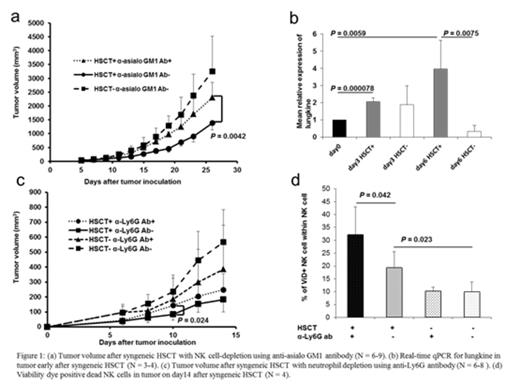Abstract
Introduction: Autologous hematopoietic stem cell transplantation (HSCT) has been thought to be important in tumor eradication induced by high-dose chemotherapy with hematopoietic stem cell rescue. It was reported recently that autologous HSCT can also induce a strong antitumor immunity by homeostatic proliferation (HP) of T cells following preconditioning-induced lymphopenia. It is known that T cell HP is driven by the recognition of self antigens, and that the availability of tumor antigens during HP leads to effective antitumor autoimmunity with specificity and memory. The effect is mediated by a reduction in the activation threshold of low-affinity tumor-specific T cells, leading to their preferential engagement and expansion. However, the mechanisms of antitumor immunity induced by the autologous HSCT are not fully understood. Especially, in addition to adaptive immunity, the role of innate immunity is unclear. In this study, we examined the role of natural killer (NK) cells on the antitumor effect in HSCT recipients using mouse xenograft models. Furthermore, since neutrophils have been reported to be required for homeostasis, maturation, and function of NK cells in human and mice (Jaeger et al. J. Eep. Med. 209:565, 2012), we focused on the interaction between neutrophils and NK cells in tumors after syngeneic HSCT.
Results: BALB/c mice were injected subcutaneously with CT26 murine colon cancer cells shortly after lethal irradiation (9Gy), and then bone marrow cells (5 x 106 cells) and splenocytes (4 x 106 cells) from syngeneic donor mice were infused into the recipient mice. Tumor growth was significantly suppressed in the HSCT recipients as previously reported (Narumi et al. Gene Ther 19:34, 2012, Udagawa et al. J. Immunol 191:3440, 2013). To clarify the contribution of NK cells to antitumor effects after syngeneic HSCT, we depleted NK cells by intraperitoneal injection of anti-asialo GM1 antibody in the HSCT recipients. The tumor growth inhibition was largely cancelled by the depletion of NK cells especially during an early period after HSCT (Figure 1a: 2303 mm3 vs. 1383 mm3 at day26; P = 0.0042). Flow cytometry showed that the frequency of surface CD107a+ NK cells, which is an activation marker, was significantly higher in tumors of HSCT recipients (24.4% vs. 6.3%; P = 0.0022) than that in non-HSCT mice, indicating that syngeneic HSCT induces NK cell activation which contributes to the antitumor effect.
Next, we examined what factor influences the activation of NK cells in tumors after syngeneic HSCT. We found that a large number of neutrophils accumulated in tumors after HSCT by immunostaining. Thus, we focused on the relationship between neutrophils and NK cells in tumors after HSCT. The cytokine antibody array showed that lungkine (CXCL15), which is one of mouse ELR+ CXC chemokine and recruits neutrophils to lung airspaces during pneumonia, was markedly up-regulated in tumor at day14 after HSCT as compared with non-HSCT tumor. The real-time quantitative polymerase chain reaction confirmed that the lungkine mRNA level was higher in HSCT-tumor at day 6 than that in non-HSCT tumor (Figure 1b: relative expression: 4.0 vs. 0.3; P = 0.0075).
Then, to investigate the effects of neutrophils on NK cells in tumors, we depleted neutrophils by an intraperitoneal injection of anti-Ly6G antibody from days 6 to 12 after syngeneic HSCT. Neutrophils were almost depleted in the spleens and tumors. The tumor growth was significantly suppressed in HSCT recipients as previously shown, whereas the depletion of neutrophil significantly increased tumor volumes in HSCT recipients but not in non-HSCT mice at day 10 (Figure 1c: 143 mm3 vs. 84 mm3; P = 0.024). Flow cytometry revealed that the neutrophil-depletion did not change the frequency of NK cells within live cells in tumors at days 14 and 21, however, neutrophil-depletion increased the fraction of dead NK cells at day 14 (Figure 1d: 32.2% vs. 19.2%; P = 0.042). Thus, neutrophils in tumors may prevent NK cells from cell death induction during HP, leading to the significant antitumor effect.
Conclusions: NK cells play a major role in the antitumor effect in the early period after syngeneic HSCT. The neutrophils in tumors may support a sustained antitumor effect of NK cells. This novel relationship reveals an important aspect of antitumor immunity induction in HSCT recipients and may contribute to the development of effective therapeutic strategy for cancer using HSCT.
No relevant conflicts of interest to declare.
Author notes
Asterisk with author names denotes non-ASH members.


